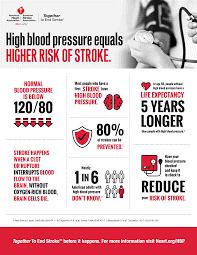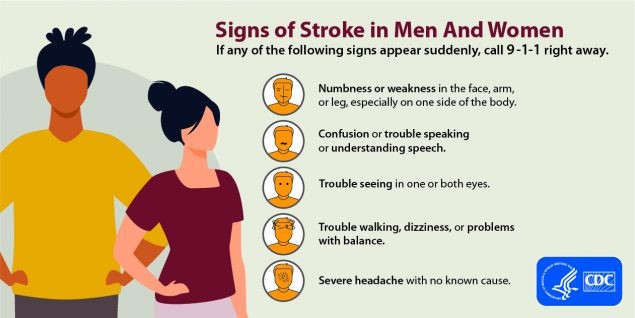
- Stroke is a leading cause of death in the United States and is a major cause of serious disability for adults.
- It is also preventable and treatable.
About Stroke
- A stroke, sometimes call a brain attack, happens in one of two ways: A blocked artery or a ruptured artery.
- A stroke, sometimes called a brain attack, occurs when something blocks blood supply to part of the brain or when a blood vessel in the brain bursts.
- In either case, parts of the brain become damaged or die. A stroke can cause lasting brain damage, long-term disability, or even death.
What happens in the brain during a stroke?
- The brain controls our movements, stores our memories, and is the source of our thoughts, emotions, and language.
- The brain also controls many functions of the body, like breathing and digestion.
- To work properly, your brain needs oxygen. Your arteries deliver oxygen-rich blood to all parts of your brain.
- If something happens to block the flow of blood, brain cells start to die within minutes, because they can’t get oxygen. This causes a stroke.
What are the signs of stroke in men and women?

- The stroke treatments that work best are available only if the stroke is recognized and diagnosed within 3 hours of the first symptoms. Stroke patients may not be eligible for these if they don’t arrive at the hospital in time.
If you think someone may be having a stroke, act F.A.S.T. and do the following test:
- F—Face: Ask the person to smile. Does one side of the face droop?
- A—Arms: Ask the person to raise both arms. Does one arm drift downward?
- S—Speech: Ask the person to repeat a simple phrase. Is the speech slurred or strange?
- T—Time: If you see any of these signs, call 9-1-1 right away.
- Note the time when any symptoms first appear. This information helps health care providers determine the best treatment for each person.
- Do not drive to the hospital or let someone else drive you. Call 9-1-1for an ambulance so that medical personnel can begin life-saving treatment on the way to the emergency room.
What behaviors increase the risk for stroke?
Your lifestyle choices can increase your risk for stroke. The good news is that healthy behaviors can lower your risk for stroke.
Talk with your health care team about making changes to your lifestyle.
- Eating a diet high in saturated fats, trans fat, and cholesterol has been linked to stroke and related conditions, such as heart disease. Also, getting too much salt (sodium) in the diet can raise blood pressure levels.
- Not getting enough physical activity can lead to other health conditions that can raise the risk for stroke. These health conditions include obesity, high blood pressure, high cholesterol, and diabetes. Regular physical activity can lower your chances for stroke.
- Drinking too much alcohol can raise blood pressure levels and the risk for stroke. It also increases levels of triglycerides, a form of fat in your blood that can harden your arteries.
- Women should have no more than one drink a day.
- Men should have no more than two drinks a day.
- Tobacco use increases the risk for stroke.
- Cigarette smoking can damage the heart and blood vessels, increasing your risk for stroke.
- Nicotine raises blood pressure.
- Carbon monoxide from cigarette smoke reduces the amount of oxygen that your blood can carry.
- Exposure to secondhand smoke can make you more likely to have a stroke.
Genetics and family history
When members of a family pass traits from one generation to another through genes, that process is called heredity.
- Genetic factors likely play some role in high blood pressure, stroke, and other related conditions.
- Several genetic disorders can cause a stroke, including sickle cell disease.
- People with a family history of stroke are also likely to share common environments and other potential factors that increase their risk.
- The chances for stroke can increase even more when heredity combines with unhealthy lifestyle choices, such as smoking cigarettes and eating an unhealthy diet.
- Family health history is a record of the diseases and health conditions that happen in your family. Family health history is a useful tool for understanding health risks and preventing health problems.
- Age The older you are, the more likely you are to have a stroke.
- The chance of having a stroke about doubles every 10 years after age 55.
- Although stroke is common among older adults, many people younger than 65 years also have strokes.
- In fact, about one in seven strokes occur in adolescents and young adults ages 15 to 49.
- Experts think younger people are having more strokes because more young people have obesity, high blood pressure, and diabetes.
- Sex Stroke is more common in women than men, and women of all ages are more likely than men to die from stroke.
- Pregnancy and use of birth control pills pose special stroke risks for women.
- Race or ethnicity People who are Black, Hispanic, American Indian, and Native Alaskan may be more likely to have a stroke than non-Hispanic Whites or Asians.
- The risk of having a first stroke is nearly twice as high for Blacks as for Whites.
- Blacks are also more likely to die from stroke than Whites are.
More information
CDC
Other Organizations
https://www.cdc.gov/stroke/index.htm